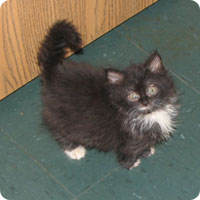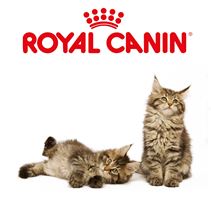FEEDING
Feeding a high-quality food is very important for your cat’s health and wellbeing. The better foods give your cat a softer, healthier coat, less foul odor to the feces, and better health.
One important factor when choosing cat food is the magnesium content. The magnesium content should be listed on the bag or can and should be less than .1%. If it is not listed or is higher than the suggested level, please do not purchase that food, as the magnesium content is too high. Cat food that is high in magnesium can contribute to urinary tract infections. Although this can be a problem for both male and female cats, it is a much more serious problem for male cats. Because their urethra is so small (about a sixteenth of an inch opening) male cats can become blocked and unable to pass any urine, which can lead to uremic poisoning. Within twenty-four to forty-eight hours, this can be a deadly situation. At the first sign of this problem (frequent, lengthy trips to the litter box or soiling in inappropriate places), the cat must be taken to your veterinarian and may need to be catheterized to remove the blockage. This is a dangerous condition for your cat and very costly for you. Most veterinarians believe that feeding food that is low in magnesium will help to prevent this problem. Foods such as Iams, Science Diet, and others are low in magnesium.
 Another factor to consider when purchasing dry cat food is to only purchase food that does not contain food coloring. Many cats have sensitive stomachs which will not tolerate food coloring well. The better foods do not have food coloring. The impact of the coloring ranges from your cat often regurgitating the food to malnutrition from not eating (or retaining) enough of the food. The better foods use very little food coloring, thus reducing the adverse impact on your cat’s digestive system. Dry foods that have many colors have these colors added to appeal to the people who purchase the food, not the cat. As cats are color-blind, they do not care about color, they only care about the smell and taste of the food. Too often the food coloring can cause vomiting and diarrhea. The food coloring will also cause nasty stains on your carpet if the cat vomits. Choosing foods without food coloring should help to alleviate many problems with vomiting and diarrhea. If vomiting or diarrhea continues, you should always consult your veterinarian immediately.
Another factor to consider when purchasing dry cat food is to only purchase food that does not contain food coloring. Many cats have sensitive stomachs which will not tolerate food coloring well. The better foods do not have food coloring. The impact of the coloring ranges from your cat often regurgitating the food to malnutrition from not eating (or retaining) enough of the food. The better foods use very little food coloring, thus reducing the adverse impact on your cat’s digestive system. Dry foods that have many colors have these colors added to appeal to the people who purchase the food, not the cat. As cats are color-blind, they do not care about color, they only care about the smell and taste of the food. Too often the food coloring can cause vomiting and diarrhea. The food coloring will also cause nasty stains on your carpet if the cat vomits. Choosing foods without food coloring should help to alleviate many problems with vomiting and diarrhea. If vomiting or diarrhea continues, you should always consult your veterinarian immediately.
For most cats, feeding dry food is preferable to feeding canned or pouch foods. Feeding a high-quality dry food is healthier for the cats and easier for the owners. Canned food has a very high water content and less overall nutritional value. Often canned food can cause diarrhea and vomiting, and most of it has an unpleasant odor. Canned food can also sour if it sits in the bowl too long, where dry food will be fine if left in the bowl. Canned food also tends to cause the cat’s feces to have a stronger, more offensive odor.
Many of the less expensive foods don’t have the proper balance of nutrients necessary to keep your cat healthy. The higher quality foods are designed to reduce the amount of “fillers” which your cat doesn’t need. Therefore, your cat will not have to eat as much quality food to derive the nutrients it needs. Bottom line, it may be less expensive overall to feed a more expensive, quality food than it would be to feed a cheaper, lower quality food. This becomes even truer when you factor in the possibility of more veterinarian bills resulting from the cat eating the cheaper food and running into urinary tract infections and other maladies. Many of the less expensive foods are not designed to help keep your cat’s teeth clean. The better quality foods all seem to have a texture designed to help remove tartar and other food residue from the cat’s teeth. Not only will kitty have better looking teeth, but also will have better breath for those of us who like kitty kisses.
We strongly urge everyone to avoid giving your cat table scraps. Most of the foods we eat are not nutritionally balanced for cats. In some cases they may be detrimental to your cat’s health. The easy answer is not to give them your food. Those people foods that can be given to your kitty include: chicken, turkey (white meat), cottage cheese, plain yogurt (unflavored), and most cheeses. In any event, if you are giving kitty these people foods, do so in moderation. Do not assume that they can exist on a steady diet of people food.
MEDICATIONS
It is difficult to emphasize enough how important it is to use the right medication(s) in treating your cat’s maladies. Too many people rely on word of mouth or the internet to give them information about how to treat their cat’s medical problems. The real answer is to consult your veterinarian when kitty is sick. It may be a lot less expensive initially to go to the local drug store or grocery and purchase an “off-the-shelf” medication, but the problem with doing that is you may be exacerbating the problem rather than helping to alleviate it.
A classic example is in the treatment of eye problems in a cat. If your cat has an infection in the eye, you may see seepage from the eye and/or inflammation of the area. Many eye medications contain cortisone to reduce inflammation. If there happens to be an ulcer on the cat’s cornea, it may not be visible to the untrained eye. In this situation, the cortisone will retard the healing of the ulcer and possibly lead to loss of vision in that eye. Suffice it to say, the best thing you can do when your cat is ill is take the cat to a veterinarian. They are the ones qualified to properly diagnose the problem and dispense the correct medication(s) to eliminate the problem.
 Another example would be in the application of flea treatments. There are a multitude of topical treatments for fleas available from your veterinarian as well as those sold in retail stores. The products provided by your Veterinarian are both safe and highly effective at removing fleas. Some of the products sold in retail outlets can actually be harmful to your pet. There have been reports of animals dying from the application of off-the-shelf flea products. The intent of these examples is not to scare you into not buying anything for your kitty at the grocery; it is intended to let you know that there may be danger in using products that are not recommended by someone qualified to prescribe the correct treatment plan.
Another example would be in the application of flea treatments. There are a multitude of topical treatments for fleas available from your veterinarian as well as those sold in retail stores. The products provided by your Veterinarian are both safe and highly effective at removing fleas. Some of the products sold in retail outlets can actually be harmful to your pet. There have been reports of animals dying from the application of off-the-shelf flea products. The intent of these examples is not to scare you into not buying anything for your kitty at the grocery; it is intended to let you know that there may be danger in using products that are not recommended by someone qualified to prescribe the correct treatment plan.
We are often asked, “What medicine do we give our cat for worms?” There are a lot of “wormers” available at your grocery or drug store. The problem is that these products are not necessarily designed to eliminate the worm(s) your cat has, as there are specific medications for different types of worms. The most common types of worms that cat owners see are tapeworms and roundworms. Tapeworms are caused by your cat ingesting a flea and are not passed from one cat to another. Roundworms, however, can be passed from one cat to another. The medication for tapeworms is different from the medication for roundworms. Again, if you suspect your cat has worms, consult your veterinarian, have a stool check on your cat’s stool, and get the correct (and safe) medication the first time.
Finally, under no circumstances should you ever give your cat any of your medicine unless you have consulted with your veterinarian. Although the cat may be able to tolerate your drugs, getting the correct dosage is of vital importance. Failing to administer the proper dosage could lead to extreme illness or death.
Bottom line, trust the treatment of your kitty’s maladies to a trained professional who can properly diagnose the problem and provide or prescribe the proper medication to make the problem go away.
If your vet does not seem to be making headway with kitty’s ailment, consult another veterinarian. This is what you would do for yourself. Why not give your pet the same opportunity? Not all veterinarians can diagnose every problem exactly right every time. Some doctors just have more experience with certain illnesses than others. Don’t be embarrassed to take your cat to another expert.
NEUTERING
Probably the single most important thing you can ever do for you cat is to have it spayed (Females) or neutered (generic for Females and Males). We cannot overemphasize the importance of this procedure to the cat’s overall health, his behavior, and your sanity. Spaying or neutering your cat does not turn them into a big, fat, useless blob as some people believe. It does tend to mellow the cat and improve the cat’s overall possibility of living a much longer, fuller life. There are some veterinarians that start spaying or neutering kittens as young as eight weeks. Some think it is safer or smarter to wait until they are 16 weeks old; there is still a contingent of old school practitioners who believe you should wait until kitty is six months before neutering. The old belief that a female should go through one heat cycle before spaying has pretty much gone away. Our recommendation for the proper age is four months. The kitty has physically progressed to the point that they can more easily withstand the surgery, but young enough to avoid having to endure the dreaded heat cycle or start spraying.
 When kitty is spayed or neutered it becomes more loving and responsive to direction from its human. Most importantly, in females it eliminates the possibility of uterine cancer and reduces the probability of breast cancer; in male cats, the risk of prostate cancer is greatly reduced. The surgery also reduces the cat’s urge to mark their territory by spraying urine. Spaying of females eliminates the possibility of infection in the reproductive organs such as pyometra (a serious infection of the uterus). Neutering of males reduces the probability of their fighting which could lead to infections/abscesses. Of course, the surgery also eliminates the ability of both the males and females to reproduce. With the overcrowding in shelters, the increasing cases of euthanasia, and the resultant growth in the population of strays, the last thing any of us needs is more reproduction of cats.
When kitty is spayed or neutered it becomes more loving and responsive to direction from its human. Most importantly, in females it eliminates the possibility of uterine cancer and reduces the probability of breast cancer; in male cats, the risk of prostate cancer is greatly reduced. The surgery also reduces the cat’s urge to mark their territory by spraying urine. Spaying of females eliminates the possibility of infection in the reproductive organs such as pyometra (a serious infection of the uterus). Neutering of males reduces the probability of their fighting which could lead to infections/abscesses. Of course, the surgery also eliminates the ability of both the males and females to reproduce. With the overcrowding in shelters, the increasing cases of euthanasia, and the resultant growth in the population of strays, the last thing any of us needs is more reproduction of cats.
There are many low-cost spay/neuter programs available to help with the expense of spaying or neutering your cat(s). Simply check with shelters in your area or in the classified ads of your local newspaper to obtain a listing of those programs available and any restrictions these programs might have. Some programs will limit their availability to low income families, while other programs will have restrictions based on the cat’s age. Many of these programs will require that kitty be current with one or more vaccines such as distemper. Some programs will not spay pregnant cats and some will. A few programs will even agree to declaw your cat, blood test for feline AIDS and leukemia, repair umbilical hernias, etc. at the same time as the spay or neuter. All of these programs are supported by licensed veterinarians.



